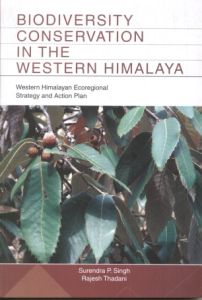 Contents:
Contents: Preface. Overview. I. The ecoregion specific approach. 1. Himalayas and the adjacent Gangetic plan - the planet's great geo-ecological anthropogenic system. II. Strategy and action Plan. Priority: 1. Balancing the approaches of environmental conservation. 2. Crop diversity and organic agriculture should be recognised and promoted. 3. Enhancing community participation. 4. The time-tested institutions of Van Panchayat of Uttarakhand should be strengthened and extended to other states of the western Himalaya. 5. Recognise the potential of livelihood oriented conservation in protected areas and other forests. 6. Revive an emphasis on natural forest regeneration, which has been undermined in forestry programmes. 7. Restructure and modernise the administrative network of forest and protected areas for conserving biodiversity and enhancing ecosystems services. 8. Re-evaluate the pros and cons of the blanket-ban on tree cutting in the Western Himalaya. 9. Recognise grazing as a major socio-ecological factor of the Western Himalaya and manage it in an integrated and sustainable way. 10. Conservation sites outside protected areas should be managed both for biodiversity and ecosystem services. 11. Strengthening of intra and inter-ecoregional co-operation for managing cross-cutting aspects of both biodiversity and ecosystem services. 12. Providing habitat corridors where critical - such as for the Western Himalayan foothill population of elephants. 13. Rejuvenation of the natural ecosystems around tourist towns where lake eutrophication and pollution has damaged biodiversity and ecosystem services including water supply. 14. Conservation of dry deciduous biome along the xeric slopes of the river and watercourses. 15. Impact of global warming on biodiversity. Literature cited. Annexures.
While this book focuses on rich biodiversity of Indian Western Himalayan region, it looks at it from a lens of culture, livelihoods and people. It acknowledges that people cannot be seen as the problem but must be part of the solution.
We stress not just on diversity - but on harder to measure and quantify values such as ecosystem services. Putting tangible numbers to these and focussing on the services this region provides is key to conservation. Not only are the Western Himalaya the cradle of many of the major rivers of the Indian subcontinent, but the water, silt and nutrients brought down from the mountains is critical to sustaining the high productivity of the Indo-Gangetic plains. Can we value these myriad ecosystem services into our national accounting?
This book also explores the role of people and institutions. The region is home to Van-panchayats (forest councils) one of the oldest institutions of common property management in the world. Can these play a role in conserving the various resources of this region? Can we even just look at forests and biodiversity without including economics and equity?
A considerable part of this book is focussed on issues and problems that threaten the forests and biota of this diverse landscape. But while flagging issues is important, more essential is to try and find solutions--something that has been attempted in this book.
Based on the strategy and action plan document for the Western Himalayan ecoregion, produced under the aegis of the national biodiversity strategy and action plan, this book has been modified and updated to keep it focussed on current problems and their solutions. It has inputs and thoughts from several sources - from experts and academicians to policy makers and mountain farmers. (jacket)
